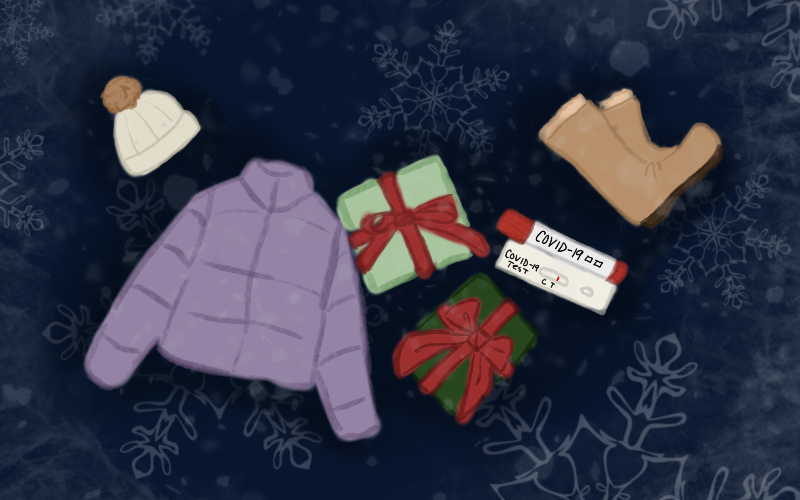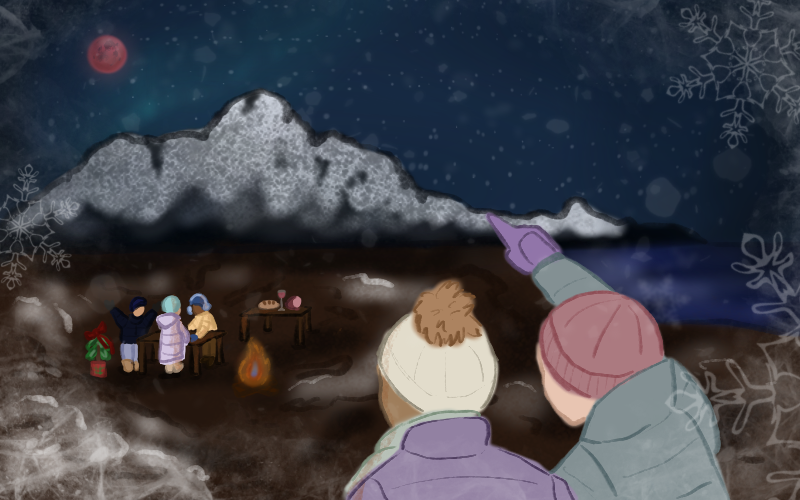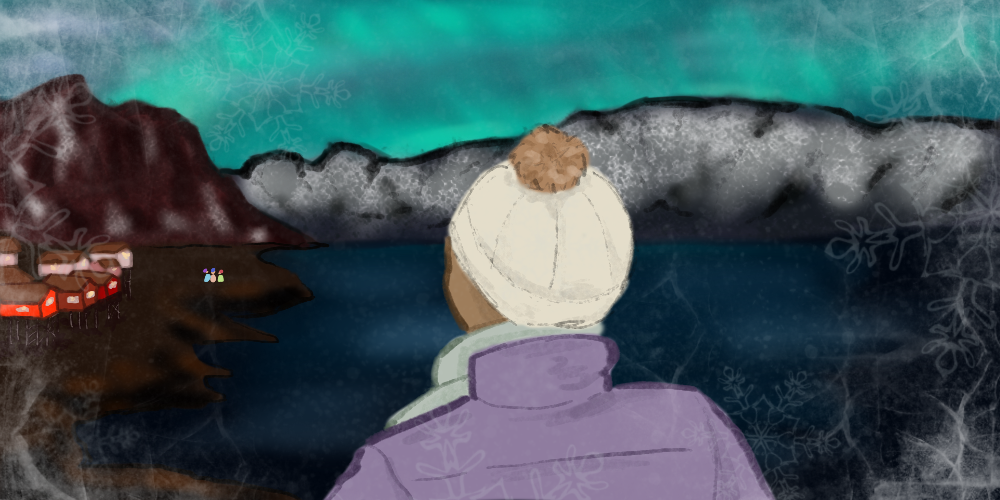It is midnight. We are walking up a road that winds itself round a mountain outside of Bergen, Norway. The walk has been lasting for what seems like an eternity already. Icy wind lunges at us now and again, scratching at our faces. My nose is red and sore from me constantly wiping it with tissues. My eyes are watering and I lower my head so that it’s parallel to the ground. Occasional lampposts bathe the asphalt in warm light, and it glimmers with hoar frost as if powdered with fairy dust. It’s too bright here, though; there’s too much light pollution. We swerve off the road and onto a footpath, looking for a sweet open spot. Our feet move tentatively along a stony trail, tree branches lashing at our faces. It is so quiet. Someone in our group turns on a flashlight and the rest of us snarl back, as we’ve just got our natural night vision going. The flashlight goes out. When it’s finally pitch dark and there’s not a tree to cover our view, we know we have arrived. There is a distant silhouette of a hill rising on the other side of the fjord, with just a scattering of houses around it. The sky is dark and rich with tiny stars. The place is perfect. The sky is perfect — perfect for watching the Northern Lights.
Everyone on my Facebook feed seemed to be going to warmer climes for Christmas in 2021, except, apparently, my husband and I. We, out of all places, chose Norway, and not even the snowy part of it — not the winter wonderland, but the rainy Bergen on the western coast. It wasn’t going to be a huge change from the rainy London, but a variation in weather wasn’t the point of our journey anyway; the trip was a reunion with friends whom we hadn’t seen in years. It was also going to be our first trip out of the country since the pandemic had started, and for frequent travelers like us, that was a long time.
Vaccinated up to our ears and with the tickets booked, we geared up with the necessities of Christmas travel: warm clothes, gifts, and Covid tests.

As I was packing my camera, I was also secretly hoping that we could catch sight of the polar lights. Even though Bergen wasn’t that far north, I heard that one could see aurora there a few times a year.
“It is a very rare thing, you know,” my husband told me. “We will be super lucky if we catch it.”
With my luck (I’m terrible with scratch cards), an aurora for Christmas would be a rare gift indeed, I thought, as rare as a hen’s tooth with a diamond stud in it. But I was game anyway.
I’m an anxious flier, usually drowning in images of a plane crashing, burning, sinking, etc., but this time I had some extra things on my worry list. I imagined a terrible scenario of not being let into Norway because of some issue related to Brexit, not being able to go back to the UK because of that same Brexit, testing positive on arrival, winding up at a hotel for a week of quarantine, and/or having our cats starve to death while in care of a cat-sitter — because no one can feed them and shovel their poop better than us, obviously.
That carousel of anxiety added unquestionable variety to my journey. A plane crash shifted to the end of my horror list. I’m not sure I even reached it, as my mind went into overload soon enough after the takeoff. In the end, I switched on my Kindle and drifted into Writers and Lovers by Lily King. I was in good company there — it felt strangely comforting to read about another person’s anxiety.
The arrival process was tedious and, thankfully, uneventful — an hour-long wait to be tested, a half-hour wait to hear the results. Apparently, the Norwegians are not happy with their tax money being directed to all that testing on the border, but it didn’t seem like too many resources were wasted anyway — there were just two officers and two medics slowly and methodically dealing with the queue of bored arrivals. To entertain myself, I started worrying about a nurse sticking a swab way too deep into my nostril, maybe damaging my brain, right before Christmas. That surely occupied me for a while. Nothing of the sort happened eventually, of course. Instead, I realized that it had always been me sticking a swab way too deep into my nose while testing myself at home, always worrying that it wasn’t deep enough. After all, people on the news were complaining that it was an unpleasant procedure, so I tried to live up to that.
We stepped from the airport into a Norwegian night — dark and quiet. No auroras yet. Instead, right across the exit doors, loomed an ambiguous slogan: “Bergen?”
I’m still not sure what those huge yellow letters really meant. Were they offering us something, like: “Bergen? Bergen, anyone?” Or were they doubting the choice of our destination? There was definitely something existential in that question mark. Were they trying to confuse us? It felt as if someone (a Bergenese, maybe?) was peeking from under a warm blanket where they had gotten all nestled up and set for Christmas with a mug of gløgg and a tin of cinnamon cookies, reluctant to expend any energy on visitors and being, like: “Bergen? Nope, haven’t heard of it.”
Light snow started tearing down from the sky. We were lucky, our friends told us as they bundled us into a car, there was going to be no rain, but a light frost and sunny weather in the days ahead. And, what a fortunate coincidence — there was a chance of seeing an aurora borealis during our visit because a special forecast was showing activity on the sun.
As expected, the weather was cold. Here I must say that I hate the cold. I hate winter, and I can manage snow as long as it lasts for a day or two at max. I can be enticed out of a warm house only with a prospect of a cozy cafe somewhere along the route. And I hate it when they say “Aren’t you a Ukrainian, aren’t you used to the cold?” No, I’m not used to the cold and I cannot walk on ice (even in high heels like all Ukrainian women seem to be able to do in people’s imagination, either).
On our winter trip to Norway, I was relying on the mild conditions of Bergen and cozy cafes. It was an unutterable pleasure to get indoors after a walk and have a hot cup of coffee. Luckily, there were many places still open before the holidays. A Christmas market was closed that year, though, while a huge pavilion stood in its usual place instead — a Covid testing center, we were told. A few people still rushed around, doing last-minute shopping. The alcohol section in supermarkets was already closed — a preventive move against heavy drinking.
After an obligatory tour of the town harbor that prided itself on old merchant houses of the Hanseatic League and a fish market with overpriced delicacies, we set out to try and catch the Northern Lights.
The hills around Bergen were studded with tidy houses, each holding a warm yellow light of a Christmas decoration in its windows — a garland, a set of candles, or a star. It was hygge incarnate, cozy and stylish. Even a cemetery was lit up with small lamps and candles that burned at every grave mark. A few people were making their way towards a modern-looking church.
“If you want to move to Norway, there is a village nearby that offers money to those who want to settle in it,” our Norwegian friend Rita told us as she steered the car along an empty road. “But you would have to do turns as a magistrate,” she added with a wry smile.
“Just watch out for those who like to roll out a Confederate flag,” Savas, our friend of Kurdish descent who now lives in Sweden, added.
According to Rita, one could still come across far-right groups of people in smaller, remote settlements, but the situation was getting better overall.
As we climbed up the mountain on the lookout for a perfect observation point, we passed by an old Nazi fortification that looked out towards the West.
“They were watching out for the Allies coming from Britain across the sea here,” Rita said, “The Norwegian coast has always been strategically attractive.”
Walking further, we saw people with flashlights busying themselves with something in a clearing. Not an ultra-right gathering, as it happened, but several Norwegian couples in puffy clothes setting up a table for a traditional pre-Christmas party — under the stars. Someone decorated a small fir tree with a garland nearby. To the north, a reddish light was rising from behind a mountaintop.
“Is that an aurora?”
“No, that’s a blood moon rising,” one of the bunch told us cheerfully.
The aurora was supposed to be coming from somewhere towards the west. We stood in the cold and suddenly still air, and watched the sky for it.

“Just a few years ago we saw it right from our balcony in the town center,” Rita said. It didn’t sound that comforting after our slog up a mountain in the middle of the night.
“But the view from here would be better, of course,” she added reassuringly.
Right, less light pollution. The auroras are at their brightest further north, of course, but even a paler version was something to look forward to. I had never seen one, and I couldn’t even imagine how it would be to watch it unfold in front of my own eyes. In my mind, the experience would be something otherworldly, something out of The Golden Compass, even though we were not even close to Svalbard.
And so we waited. And nothing was coming out of it. A large vessel was making its way along the fjord. A few cars were crossing a bridge to a nearby island. The pre-Christmas party behind us was underway, glasses clinking like bells. It was hard to give up hope, but the sky remained implacably dark. Except for the reddish glow of the moon.
On the way down to the parking lot, the time flew faster than it had on the way up. The wind died down completely and the air was pleasantly crisp. The grass growing on both sides of the road was soft and crunchy with silver frost under our feet. The magic of it was some consolation. Not seeing the Northern Lights made the sight of them somehow even more desirable.
“Don’t worry,” my husband told me, “I saw aurora only once in the ten years that I lived in Sweden.”
At that moment, at least one more and much longer trip to Scandinavia suddenly seemed possible to me. I felt like I could even sacrifice myself to snow and freezing temperatures for the Lights. The cold is not that bad, after all, I thought. Especially when you dress up better — there is no bad weather, as they say. It’s so refreshing to be out and about in nature, breathe in some cool air, I was telling myself. I could manage that, one day.
Now it was the right time to cuddle up with wine and food, movies, and Scrabble, though. The next few days would see very few people outdoors, including us. We would be sharing what was scarce in the last two years of social distancing — human contact, finally, offline. It seemed as rare as an aurora borealis recently, and it was something that we were able to catch that night.
As we boarded our plane back to London, there were no more troubled thoughts for me. I felt, strangely, at peace. Lily King’s character was also having a respite from her fears. There had been no aurora for us on that journey, but when we approached England, the earth shone with pools of golden light under our plane: towns, villages, and glorious London itself — brilliant with the double strength of all those Christmas decorations. It was like seeing islands of hope in the sea of darkness — so many people gathering together, at last. That was a sight worth seeing, maybe less stunning than the Northern Lights, but warming my heart nevertheless. •




